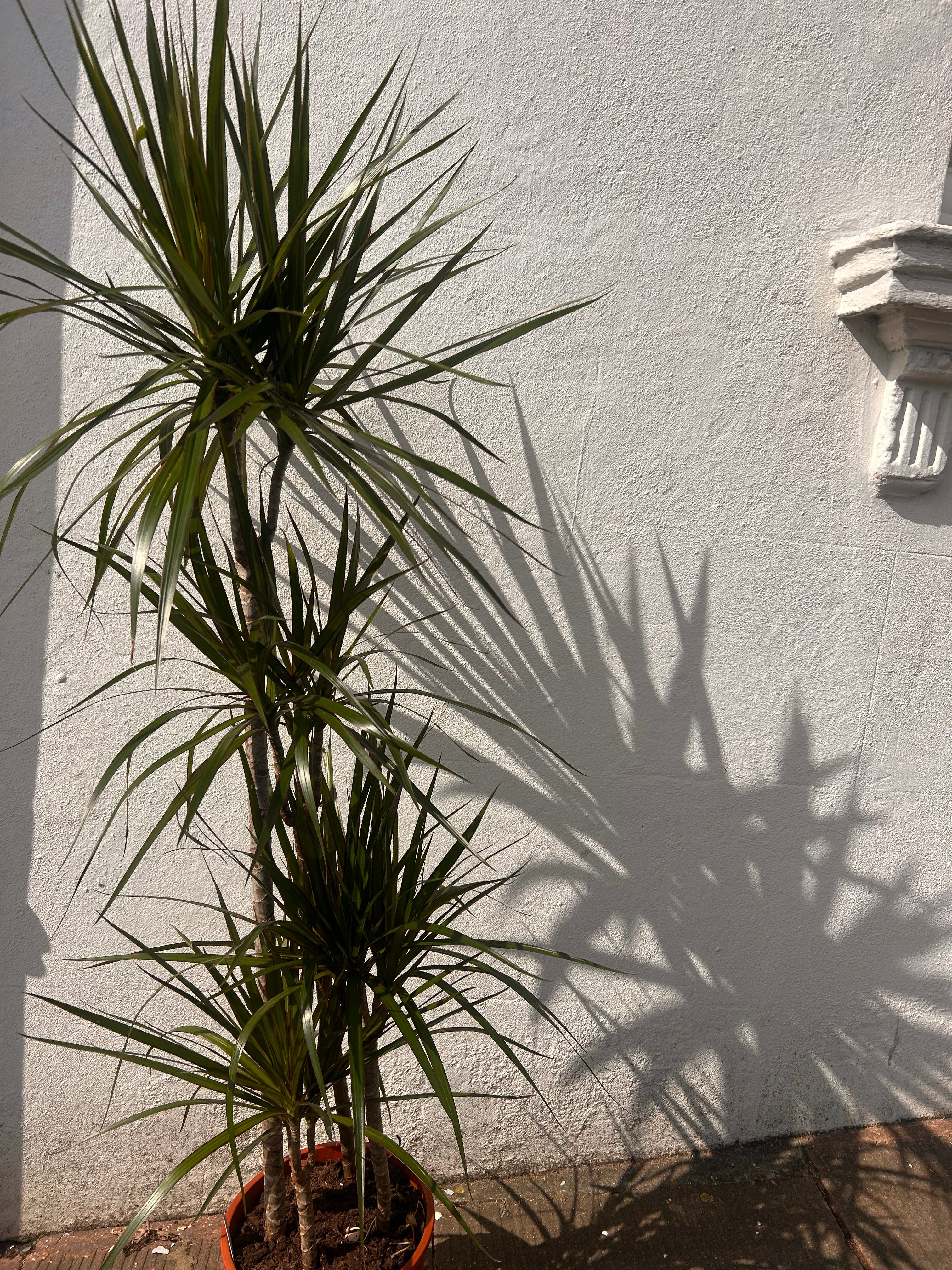The Dracaena Marginata is great for adding some height to your collection of plants, being able to support itself with its sturdy stem and keeping a slender and tall appearance even when growing to its full height. The Dracaena has slender dark green sworded shaped leaves edged with red. Dracaena is a genus of over 120 species of trees, the biggest being the Dracaena draco, which can grow to around 25 ft tall. Dracaena is derived from the Greek name for a female dragon ‘Drakaina’ this refers to the green foliage and red sap that resembles blood that can be found in the draco variety. The botanical symbol of Tenerife which is also home to one oldest but also of the largest Dracaena in the world. It is estimated that this tree is between 250 and 350 years old.
Dracaena Marginata are one of our more unusual houseplants here at Between Two Thorns - if you're looking for rare or unique houseplants then look no further!
Dragon Tree Overview
Dracaena Marginata, more commonly known as the ‘Dragon Tree’ are loved for their low maintenance care and being a beautiful house plant. Native to Madagascar, these plants have slender dark green leaves with dark red edges, making them a stunning yet hardy houseplant for any home. The Romans believed this plant to have many myths behind it as it was thought to be related to a dragon with 100 heads, however, in Chinese culture this plant is also thought to be a symbol of good luck.This plant will thrive in your bathroom or kitchen due to its need for humidity, however, will survive in any other room if needed, as long as it isn’t in direct sunlight.
How to Look After a Dracaena Marginata (Dragon Tree)
Light:
Dragon trees prefer bright, indirect sunlight. Avoid direct sunlight as it can scorch their leaves. Can tolerate a shadier location though this will result in slower growth.
Temperature and Humidity:
Maintain a temperature between 12-32°C and like medium humidity levels. Mist your plant regularly or place it near a humidifier to create the perfect environment. Avoid putting near cold drafts or heat sources. This plant will benefit from a shower from time to time to keep the leaves dust free.
Watering:
Water your Dragon tree when half of the soil feels dry. It's better to underwater your plant than overwater, as too much moisture can lead to root rot. Use a well-draining potting mix. Reduce watering in winter. If your plant is in a shadier location it will need less water than those grown in brighter locations.
Fertilizing:
During the growing season (spring and summer), feed your Dragon tree once every 4 waters with a balanced liquid fertilizer, it is always advised to follow the instructions on your fertilizer. Reduce feeding in the dormant winter months.
How to Re-pot a Dragon Tree
Re-pot your Dragon Tree when it becomes root-bound or outgrows its current pot, typically every 2-3 years. Choose a pot that's one size larger, provide fresh, well-draining soil, and gently transfer your plant, being careful not to damage the roots. Hydrate your plant 24 hours before you repot.
How to Propagate a Dragon Tree
Propagating a Dragon tree is an exciting way to grow new plants. Follow these steps:
- Choose a Healthy Stem: Select a stem near the top with new growth with a woody stem.
- Cut the Stem: Use a clean, sharp knife or scissors to cut. Ensure your cutting is at least 6 inches (15 cm) long. Remove bottom leaves.
- Rooting: Place the cutting in lukewarm water or moist soil. Roots should develop within a few weeks. If using water, make sure to change the water every week. Place in a bright indirect spot.
- Transplant: Once your cutting has well-established roots, transplant it into a pot with the appropriate soil mix.
How to Prune a Dragon Tree
Pruning your Dragon tree helps maintain its shape and encourages healthy growth. Remove any yellow or brown leaves.
How to Take a Cutting from a Dragon Tree
Taking cuttings for propagation follows a similar process as mentioned earlier. Ensure you choose a healthy stem, make a clean cut, and follow the propagation steps.
How Often Should I Water a Dragon Tree?
Watering frequency depends on various factors like humidity, temperature, and pot size and location. As a general rule, check the top third of soil and water when it's dry. Water less in winter and more frequently during the growing season.
Why Are My Dragon Tree Leaves Going Yellow/Brown/Curling?
- Yellow Leaves: Yellowing leaves can result from overwatering, poor drainage, or too much direct sunlight. Adjust your watering and lighting conditions accordingly. If the leaves are wilting and yellowing it is most likely to be due to overwatering, check the roots for rot and re-pot if necessary.
- Brown Leaves: Brown edges or spots may indicate low humidity, underwatering, or direct sunlight. Increase humidity and adjust your watering routine. Too much warmth, for example, if the plant is next to a radiator, can cause brown leaves that dry up and fall off.
- Curling Leaves: Curling leaves can be a sign of underwatering, over-fertilization, or low humidity. Ensure proper watering and humidity levels.
How to Make a Dragon Tree Bushy
Encourage bushier growth by pruning leggy stems. Ensure your Dragon tree has enough light, lack of light can cause this plant to become leggy.
Are Dragon Trees Poisonous to Cats and Dogs?
Yes, the Dragon tree is considered toxic to cats and dogs. If eaten this plant can cause vomiting, nausea and a loss of appetite seek medical assistance if large quantities are eaten. Keep your Dragon tree out of reach of pets or opt for pet-friendly houseplants.
With these expert tips, you're well-equipped to care for your Dracaena and enjoy its lush, tropical beauty in your home. Happy Dragon tree growing!


























